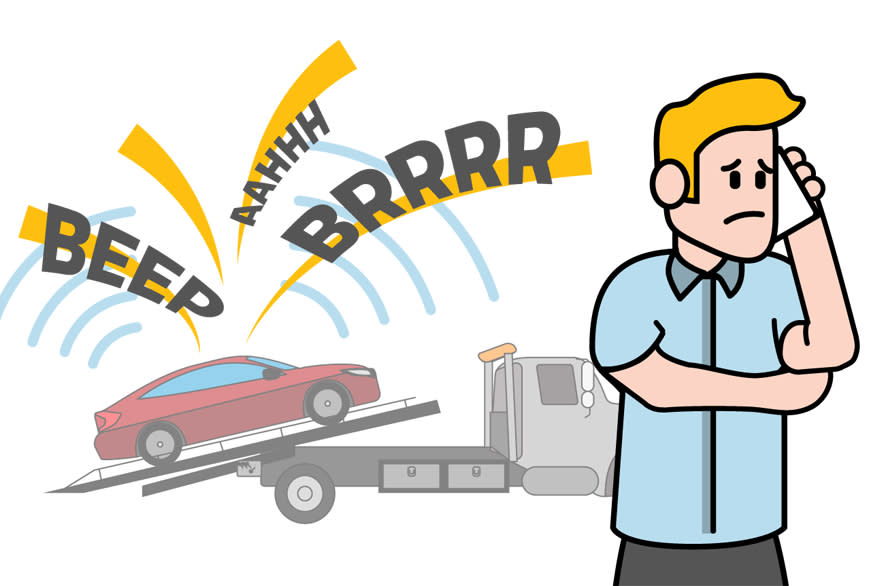
We ransacked our room, our bags, and our clothes. My girlfriend and I inspected the kitchen, the deck, and the, um, lovely space behind the toilet. We dumped every single trash bag from the house and re-bagged. Twice. Our quaint Airbnb, in Lake Placid, New York, was stealing my sanity.
I had lost our rental car keys.
On Sunday, a AAA representative assured us that a locksmith in Plattsburg, New York, (41 miles away) would arrive Monday, 9 a.m., with a key. Something about this seemed too good to be true. We decided to enjoy our last day in the Adirondacks with a walk and a beer, exhausted from picking apart the house. Monday morning came, and the locksmith was out. In hindsight, we could have used the full day to find another option, but the AAA agent was so reassuring. I prepared to pay $400 for a tow to the nearest Avis location. An Avis representative explained that a series of back-end system failures prevented Albany (139 miles toward home) from helping. The local auto company arrived and quickly mounted the civic to the flatbed. Our only option was to travel with the driver, Bob, to Burlington, Vermont…90 miles away.
I soon learned that the local towing company provides 15 to 20 rides a week for similar services, two hours each away on average. We were dropped in Burlington, where the Avis rep explained that he had a car for us…at the Burlington airport. A reluctant Uber ride later, Joe, our Avis rep at the Burlington Airport (and our savior), explained a litany of dropped calls, system mistakes, and incorrect paperwork that contributed to our epic communication breakdown. “On behalf of Budget and Avis—honestly, I have to say this about a dozen, maybe 15 times a week—I apologize. We totally dropped the ball and I will make this better.”
A lovely Kia carried us through Vermont all the way to a locked garage in Boston. In the garage, I sat on hold for 15 minutes while searching for options to dump the car for the night. I lost service for a moment but was soon jumping through automated phone hoops. I paid $13 dollars as I exited the garage, and then finally reached a representative who extended my rental until the next morning. In the end, we settled on zero extra fees.
And so?
A pleasant weekend trip could have turned from an investment of a few hundred dollars for relaxation into a bill of a few thousand dollars for repairs. But, thanks to some smart, enabled frontline employees, the company made a strong recovery. When mistakes happen, customer feelings become agitated until the issue reaches a resolution—no matter the cause. Looking back at this saga, I see three lessons:
Lesson One: Think one step ahead of your customers. Make options clear and easily accessible so they don’t have to search for help. When customers need help, their eagerness to pursue your company’s recovery policy depends on their view of corporate service contracts, the value of the commodity, and their tolerance of risk. For customers in this position, a major portion of the mental process is accepting the situation and evaluating options. To provide options for a proper recovery, you must understand you customers’ risk tolerance and relevant arrangements.
With rentals, customers have the choice to purchase extra coverage or seek outside protection. Customers with a low risk tolerance will reduce the scope of their options. In a recovery with higher value, there is a higher emotional stake.
When a customer is handed off between agents or interfaces, information becomes extremely precious, and emotionally sensitive. Ask the important questions up front and use this relevant information to construct customer profiles. If they elect to cover their own expenses, provide an option to explain to employees why they turn down the insurance. Empower your workforce to provide a call to action instead of a list of data to gather.
The higher the value and lower the risk tolerance, the more likely customers will seek out a third-party solution, if possible. In-house assistance provides you an exclusive chance to create and maintain a positive impression. A case resolved through a third-party solution is a missed opportunity for lasting brand integrity. And if all else fails, the customer will return to you for help, more frustrated after events that are out of your control.
Lesson Two: Be aware of industry innovations, especially your own. Customer expectations develop organically. Digital spaces create new interactions, and customer experiences now evolve faster than companies could previously track. A successful gesture or interaction influences a generation of impressions.
When a company acquires an industry disruptor, they can reflect the disruptor’s design choices in their product or use the intellectual rights to mitigate being overtaken by a new idea. Zipcar and other car-share services introduced keyless entry and device control into their rental process. They created a new sense of what is possible for accessing a car. The traditional process of vehicle rental calls up visions of paperwork and last-minute panic attacks to fill up the tank before returning. Zipcar and other brands stripped away undesirable touchpoints in the process. Today, we can stroll up to a Civic named Amador, or The Lover, and wave a plastic card over the windshield.
When Avis Budget Group, with over 9,000 locations in North America, acquired Zipcar, they also absorbed the expectations of the Zipcar brand. Brands that connect under an umbrella must also adapt to their own operational strengths. Without this consistency, customers and employees experience different tiers of expectations and not one single benchmark. Companies in this model cannot set an ideal experience or set the tone for instilling confidence in a buyer. Once a cog falls out of the machine, the system is not designed to recover. The worst-case scenario in this space is a customer knowing a competitor can solve their problem more effectively.
Lesson Three: When a customer needs help, the transactional nature of a purchase creates a perceived adversarial showdown between customer and company. Depending on a customer’s risk tolerance, the default recovery path may cost too much. The thought of paying large sums of money to escape a situation puts customers in a defensive position. This dynamic builds emotional pressure that is ready to release at the sign of a breakdown. If a step in the recovery process goes poorly, the downwards trending experience grabs hold of an anvil. The slices of information employees use to explain solutions matter greatly to a customer’s assurance. An Avis customer in a red Honda does not want to hear on the phone: “We have you listed as a Budget customer in a silver Kia.” This convinces the customer that progress is lost.
Internal systems do not make or break a customer experience. The results of those systems and the end solution are paramount. An observation of a past event, a past conversation, or an error along the way may help provide context, but it traps the conversation around the issue instead of the solution. When providing information to a customer in need, whether that be an explanation of the problem or the steps to salvation, the points that drive action will more likely drive positive change.
Allow for Empathy
A powerful brand conveys unified success. As systems evolve and companies tie together years of technological growth, a person’s decision making will always depend on the information available. Customers operate on what they have in front of them, and they expect that their input matches what they see and hear in return. Employees depend on their tools to make the right decisions and provide assurance in a recovery. An operation designed to connect people rather than programs allows for empathy, and this value can make all the difference when you need help.





